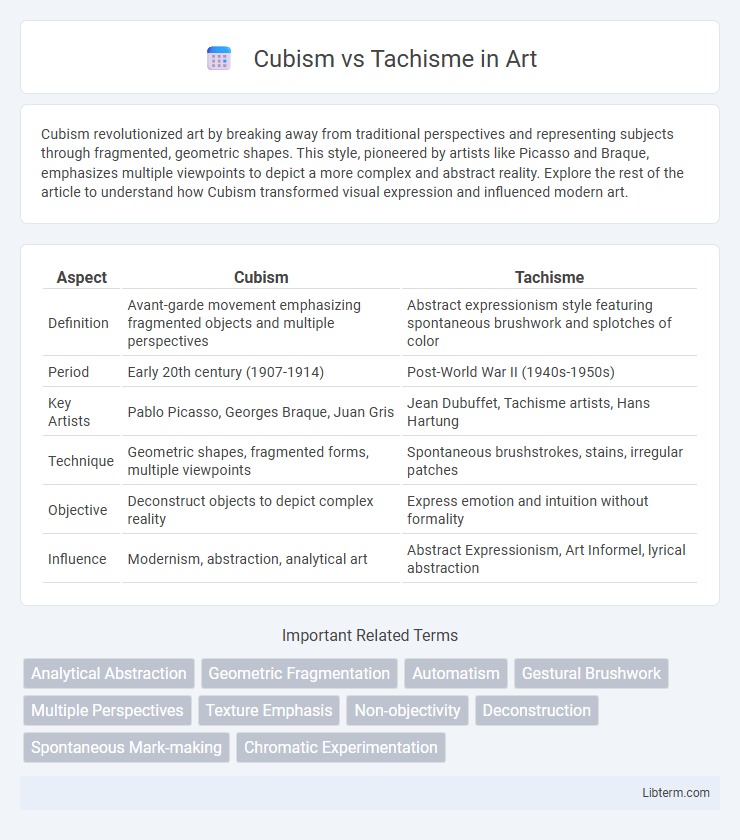Cubism revolutionized art by breaking away from traditional perspectives and representing subjects through fragmented, geometric shapes. This style, pioneered by artists like Picasso and Braque, emphasizes multiple viewpoints to depict a more complex and abstract reality. Explore the rest of the article to understand how Cubism transformed visual expression and influenced modern art.
Table of Comparison
| Aspect | Cubism | Tachisme |
|---|---|---|
| Definition | Avant-garde movement emphasizing fragmented objects and multiple perspectives | Abstract expressionism style featuring spontaneous brushwork and splotches of color |
| Period | Early 20th century (1907-1914) | Post-World War II (1940s-1950s) |
| Key Artists | Pablo Picasso, Georges Braque, Juan Gris | Jean Dubuffet, Tachisme artists, Hans Hartung |
| Technique | Geometric shapes, fragmented forms, multiple viewpoints | Spontaneous brushstrokes, stains, irregular patches |
| Objective | Deconstruct objects to depict complex reality | Express emotion and intuition without formality |
| Influence | Modernism, abstraction, analytical art | Abstract Expressionism, Art Informel, lyrical abstraction |
Introduction to Cubism and Tachisme
Cubism, pioneered by Pablo Picasso and Georges Braque in the early 20th century, emphasizes fragmented objects and multiple viewpoints within a single plane to challenge traditional perspectives. Tachisme, emerging in post-war Europe during the 1940s and 1950s, is characterized by spontaneous brushwork, abstract forms, and vibrant color splashes, reflecting an emotional intensity and rejection of structured composition. Both movements revolutionized modern art by breaking away from realism, yet Cubism focused on analytical deconstruction while Tachisme embraced intuitive expressionism.
Historical Origins and Development
Cubism, emerging in the early 20th century around 1907 with pioneers like Pablo Picasso and Georges Braque, revolutionized art by fragmenting objects into geometric shapes and multiple perspectives, marking a shift from traditional representational art. Tachisme developed in post-World War II Europe during the 1940s and 1950s as a key movement within abstract expressionism, characterized by spontaneous brushstrokes and a focus on color and texture over form, embodying emotional intensity and freedom. Both movements reflect significant shifts in modern art history: Cubism rooted in analytical deconstruction of reality and Tachisme evolving as an expressive response to the trauma and existentialism of the mid-20th century.
Key Influencers and Artists
Cubism, pioneered by Pablo Picasso and Georges Braque in the early 20th century, revolutionized visual art through fragmented forms and multiple perspectives emphasizing geometric abstraction. Tachisme, emerging in the 1940s as part of the European Abstract Expressionism movement, was championed by artists such as Jean Dubuffet and Pierre Soulages, focusing on spontaneous brushstrokes and textured surfaces to convey emotion. Both movements significantly influenced modern art, with Cubism laying the groundwork for abstract representation and Tachisme emphasizing gestural freedom and materiality.
Core Philosophies and Artistic Goals
Cubism centers on deconstructing objects into geometric shapes to represent multiple viewpoints simultaneously, aiming to challenge traditional perspectives and depict the complexity of form. Tachisme emphasizes spontaneity, emotional intensity, and the physical act of painting, often using abstract, irregular blotches and strokes to express subconscious feelings. Both movements reject classical representation but diverge as Cubism prioritizes structured analytical observation, while Tachisme focuses on unrestrained, intuitive expression.
Visual Characteristics and Techniques
Cubism emphasizes fragmented, geometric shapes and multiple perspectives in a single composition, employing analytical techniques like faceting and simultaneous viewpoints. Tachisme features spontaneous brushstrokes, irregular splotches, and drips of paint, prioritizing emotional expression through gestural abstraction and improvisation. While Cubism uses structured, deliberate construction, Tachisme embraces randomness and a dynamic, textured surface.
Relationship with Abstract Art Movements
Cubism pioneered the fragmentation of form and multiple perspectives, laying the groundwork for many abstract art movements by dismantling traditional representation. Tachisme, emerging later in post-war Europe, emphasized spontaneous brushwork and emotional intensity, aligning closely with Abstract Expressionism's focus on improvisation and subconscious creation. Both movements contributed to the evolution of abstraction by challenging conventional aesthetics and exploring new modes of visual expression.
Impact on Modern and Contemporary Art
Cubism revolutionized visual representation by emphasizing fragmented forms and multiple perspectives, deeply influencing modern art movements such as Futurism and Constructivism. Tachisme, characterized by spontaneous brushwork and abstract forms, contributed significantly to the development of Abstract Expressionism and informal art in the mid-20th century. Both movements challenged traditional aesthetics, paving the way for experimentation in contemporary art practices worldwide.
Critical Reception and Public Perception
Cubism, pioneered by Pablo Picasso and Georges Braque, was critically acclaimed for its revolutionary approach to representing multiple perspectives and reshaping modern art, gaining widespread acceptance among art critics and intellectuals. Tachisme, emerging in post-war France with artists like Jean Dubuffet and Pierre Soulages, received mixed reviews due to its emphasis on spontaneity and abstraction, challenging traditional aesthetics and often polarizing public opinion. The public generally embraced Cubism's structured fragmentation, while Tachisme's emotive and impulsive brushwork attracted avant-garde supporters but puzzled mainstream audiences.
Legacy and Influence in Today’s Art World
Cubism's legacy lies in its revolutionary approach to perspective and form, profoundly influencing modern art movements and contemporary visual language. Tachisme, emerging as a European response to Abstract Expressionism, introduced spontaneous, gestural brushwork that shaped post-war art's emotional intensity and emphasis on process. Both movements continue to inspire artists today, informing diverse practices from digital abstraction to mixed media installations, underscoring their enduring impact on artistic innovation.
Conclusion: Comparing Cubism and Tachisme
Cubism deconstructs objects into geometric shapes, emphasizing multiple perspectives and structured composition, while Tachisme embraces spontaneous, abstract expression through irregular brushstrokes and color splashes. Cubism's analytical approach contrasts with Tachisme's focus on emotional intensity and freedom in form. Both movements revolutionized 20th-century art by challenging traditional representation, yet Cubism prioritizes intellectual analysis whereas Tachisme emphasizes raw, intuitive creativity.
Cubism Infographic

 libterm.com
libterm.com